As the yowie mobile rounds another hairpin, I grip the steering wheel a little tighter and stretch my neck to see if there's any oncoming traffic. You don't want to take chances on this remote road of endless switchbacks which slices through the rugged realms of the Brindabellas.
Through occasional breaks in the thick regrowth from the 2003 bushfires, I catch glimpses of the jagged spine of the Tidbinbilla Range which rises high out of the eastern side of the valley below. It looks unfamiliar from this angle - it's not the profile of the recognisable cradle of peaks that hold the gaze of many when looking to Canberra's western horizon. It looks different from the other side.
After negotiating yet another blind corner, I'm confronted with an unexpected sight. Staring at me from the far side of the gorge and etched into the cliff is a giant face. It's the result of eons of wind and water erosion, but its noticeable nose and watchful eyes are so realistic that you could easily be excused for thinking it had been hacked purposefully out of the rock. It stands sentinel, like a giant guardian, keeping a close eye on everything and everyone who ventures into its domain. No doubt it has watched over countless journeys of indigenous moth hunters who for thousands of years made their annual pilgrimage through these mountains to source protein-rich bogongs aestivating in rock crevices on the higher peaks. Oh, if it could only talk.
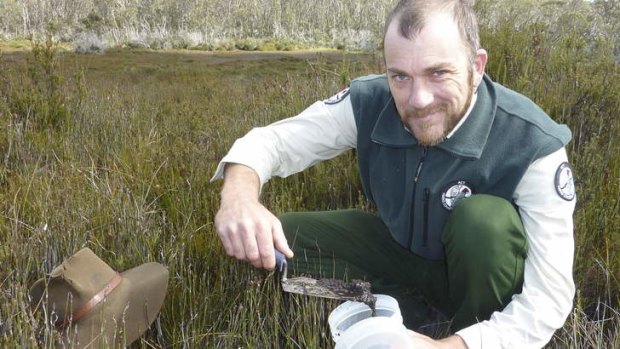
Ranger Brandon Galpin collects silts from an alpine bog in the Brindabellas.Credit: Tim the Yowie Man
I'm bumping my way along to Bendora Dam, which along with better-known Cotter, Googong and Corin supplies much of our drinking water. Although the gravel road is suitable for 2WD, few ever make the trip to this far-flung reservoir.
Although the dam is the end point of the road and the short stroll down to view its double curvature concrete arch is worthwhile, it's not this engineering feat (a first for its type in Australia) which has lured me into this wild swathe of high country - I'm here to soak up the natural splendour. From a landscape perspective, this is the gateway to the heart of Namadgi National Park and the whole concept of the Australian Alps - remote wilderness and big mountains.
The ACT Parks and Conservation Service (and prior to that the ACT Forestry Service) have had a ranger on duty at the dam since the early 1960s. Arguably it's the ACT's most remote job and the latest in the line of Bendora rangers is Brandon Galpin, who has agreed to show me around part of his patch.
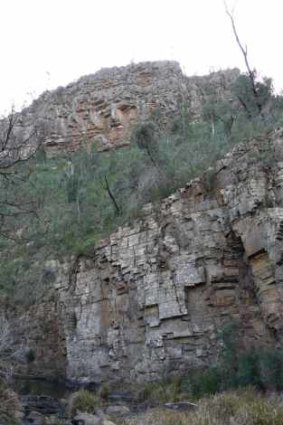
The ‘guardian’ face in a rock. Can you see it? If not scroll down for a close-up.Credit: Toby Jones
I meet the affable khaki-clad Galpin at Bendora Ranger HQ - which is alongside a modern, purpose-built home which houses his family. His kids must have the toughest (read: roughest and longest) trip to school in Weston Creek of any ACT students. "It's not the easiest commute, but hey, it's worth it to have this as your backyard," says Galpin as he points to the spread of mountains above and valleys below.
With today's satellite communications, it's not as remote as it once was, but the job of Bendora ranger still comes with its challenges. Not the least is the climate. In his book Rugged Beyond Imagination (National Museum of Australia Press, 2009) high country historian Matthew Higgins reports that Eamonn Waldron who worked on the dam during its construction "was once snowed in for two weeks and with telephone lines down there was absolutely no contact with the outside world. He and his workmates survived on trout."
"Part of the gig is the smoke in summer and the winter hardship, but after a while you learn the ability to read the landscape and know what needs to be done - the snow and the fire management," explains Brett McNamara, a former Bendora ranger (1993- 98) who is now regional manager, national parks and catchments with the ACT Parks Service.
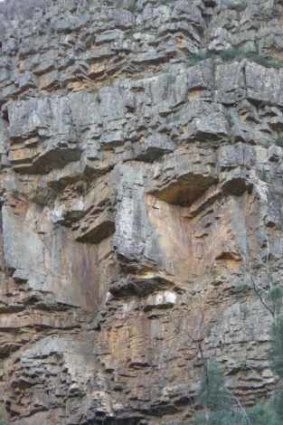
The ‘guardian’ face in a rock. Can you see it now?Credit: Toby Jones
McNamara recalls fondly his time as the Bendora ranger. "There's a real sense of remoteness and ruggedness and you are there to look after it," recounts McNamara, who adds, "words like 'privilege' and 'special' spring to mind, so too 'beauty', and 'majestic'." McNamara especially remembers waking up on winter mornings and looking beyond the waters of Bendora to the snow-topped Brindabella range. "I could basically look out the window and know what roads needed to be closed," explains McNamara.
Although now based "at the big smoke" at Namadgi Visitor Centre near Tharwa, McNamara relishes the opportunity to return to his old patch whenever he gets a chance. "You can take the mountains off the ranger, but you can't take the ranger out of the mountains," he muses.
And he's right. Although only one year into his isolated posting, it's soon clear Galpin has already fallen under the Bendora spell.
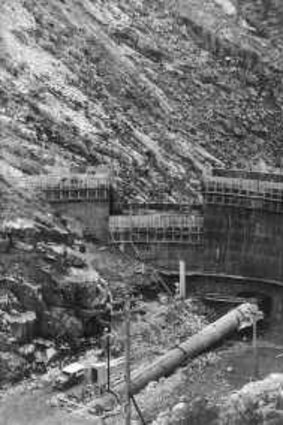
Bendora Dam under constructionCredit: Arthur Mostead/ ACTEW Water
I've joined Galpin on patrol for the morning and our first scheduled stop is Bendora Arboretum to check all is in order for an upcoming open day. However, just as we lurch up the Bendora Break fire trail, Galpin's CB radio crackles into action. The researchers at the Endangered Species Breeding Program for the critically endangered northern corroboree frog at Tidbinbilla need some silt from the frog's natural habitat and have asked Galpin if we can collect a jar of it. The arboretum patrol will have to wait. But hey, what's another 30km of traversing mountain tracks?
After a squirt of disinfectant on our boots (pathogens can't be brought into this ultra-sensitive last bastion of the frog) and with trowel and jar in hand we trudge into the remote sphagnum bog.
Mission accomplished and with the payload of silt securely stashed away in the back of Galpin's landcruiser, an hour later we are rattling down the Mt Franklin Rd to Pryors Hut. Here the importance of water catchment is obvious for anyone who needs to answer the call of nature - the hut's rudimentary toilet is just on the NSW side of the border, which means it's just out of the Cotter catchment. Water quality has been a serious matter in these parts for some time - one of the first pieces of legislation passed after the formation of the ACT was the Cotter River Ordinance (1914-59) in which you virtually needed written ministerial approval to have a picnic within cooee of the Cotter catchment.
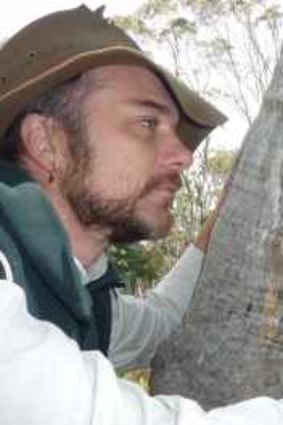
Ranger Galpin checks out an historic blaze in a tree marking an old road alignment in the BrindabellasCredit: Tim the Yowie Man
Most of Galpin's patch sits below the snowline, so a lot of his work day is spent toiling in the tall timber country, and on the way back towards Bendora Arboretum he stops to show me his favourite tree - a grand old alpine ash that somehow survived the logging regime (pre national park) and also escaped the firestorm of 2003 relatively unscathed. He doesn't quite hug it, but I reckon if I were to look the other way he probably would.
Having worked for many years in the Never Never of the Northern Territory, Galpin has a deep appreciation of indigenous heritage but also treasures the European heritage of his patch, and further on we pull up by an old tree with ''7½'' carved into it. It's a reference tree from the original survey of the Mt Franklin Rd in the 1930s which indicates the distance from the beginning of the road at Piccadilly Circus (7½ miles). It's a real treat to see it; who knows how much longer it will survive the ravages of time.
We finally make it to the arboretum, home to more than 50 different species of conifers, larches, spruces, firs and white pines planted here in the early to mid-1900s. Now, when the larches and other deciduous varieties are changing colour, is the best time of the year to visit, but it's what grows amongst the roots of the trees that interests two young girls who we stumble on exploring the secret forest with their dad. "We've been taking photos of the fairy-like mushrooms [photogenic red with white spotted fly algaric mushrooms (amanita muscaria)],'' proudly blurts one girl to Galpin as we pull up.
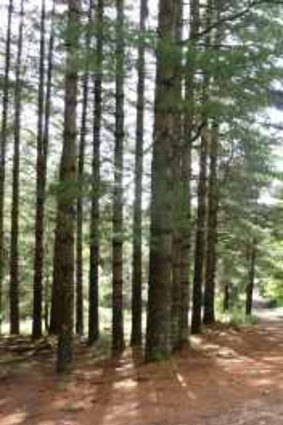
The towering trees of Bendora ArboretumCredit: Tim the Yowie Man
Galpin reminds the girls not to touch or pick any wild fungi as some species can be harmful. He shows them through the hut and then drives on - he can look forward to an afternoon on the chainsaw clearing fallen trees..
I've spent three hours with Galpin and already feel a strong affinity for this high country. I don't want to leave (let alone face that road again). Imagine what a few years up here can do for you. Little wonder McNamara waxes so lyrical about his old stamping ground.
I dip my hat to Galpin and his predecessors who have looked after and continue to be modern-day custodians of this special part of the ACT.
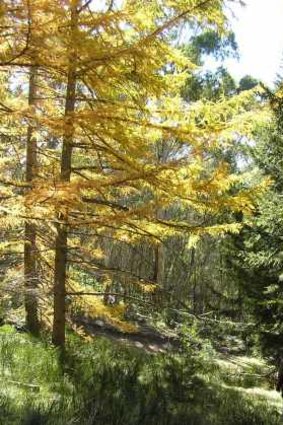
Japanese larch (planted in 1951) in their autumn glory in Bendora Arboretum.Credit: Alan Brown
As I wind my way back along the road homeward bound, I glance over my shoulder and give half a wave to the giant face in the rock - a sure sign that I, too, have fallen under the spell of beautiful Bendora.
FACT FILE
Bendora Dam: Located at the end of Bendora Road, a 90-minute drive from Civic via Mount Franklin Road (gravel). The road is suitable for 2WD but take care, especially with oncoming traffic. From the car park, it is a 400-metre walk to the top of the dam wall.
Don't miss: The ''guardian'' face in the cliff. Best viewed from Bendora Road, near its intersection with Burkes Creek Road.
Tim's tip: Although access to the top of the dam wall is prohibited (and fenced off), when walking back up the hill from the dam to the car park, take the first track on your right - it'll take you down to Cow Flat, a lovely picnic area (no facilities) near the spillway.
Bendora Arboretum: Located 1.3 kilometres along Chalet Road from a locked gate near its junction with Mount Franklin Road. Allow an hour or so to stroll among the towering pines and other exotic species.
Don't miss: At 10.30am, Sunday May 18 the Bendora Ranger and Friends of ACT Trees will be hosting a guided tour of the Bendora Arboretum. The tour involves about 3½ kilometres of walking. Bookings are essential: Ph: 6207 2900.
CONTACT TIM
Email: timtheyowieman@bigpond.com or Twitter: @TimYowie or write to me c/o The Canberra Times, 9 Pirie Street, Fyshwick.
A selection of past columns is available at: canberratimes.com.au/travel/blog/yowie-man.
Sign up for the Traveller newsletter
The latest travel news, tips and inspiration delivered to your inbox. Sign up now.